The Impact of Smartphones on Work-Life Balance: A Detailed Analysis
VerifiedAdded on 2021/04/21
|7
|1548
|34
Essay
AI Summary
This essay delves into the complex relationship between smartphone use and work-life balance, examining the claim that smartphones enable employees to achieve a better balance. The essay argues against this claim, citing instances of increased stress due to constant connectivity and blurred boundaries between work and personal life. It explores how smartphones, while offering benefits like flexible work arrangements and remote access to information, also contribute to work-family conflict, reduced job satisfaction, and potential burnout. The analysis considers the addictive nature of smartphones and their impact on personal time, emphasizing the need for employees to establish boundaries and prioritize family values to succeed both professionally and personally. The essay references various studies to support its arguments and concludes with a call for employees to manage their smartphone usage to maintain a healthy work-life integration.
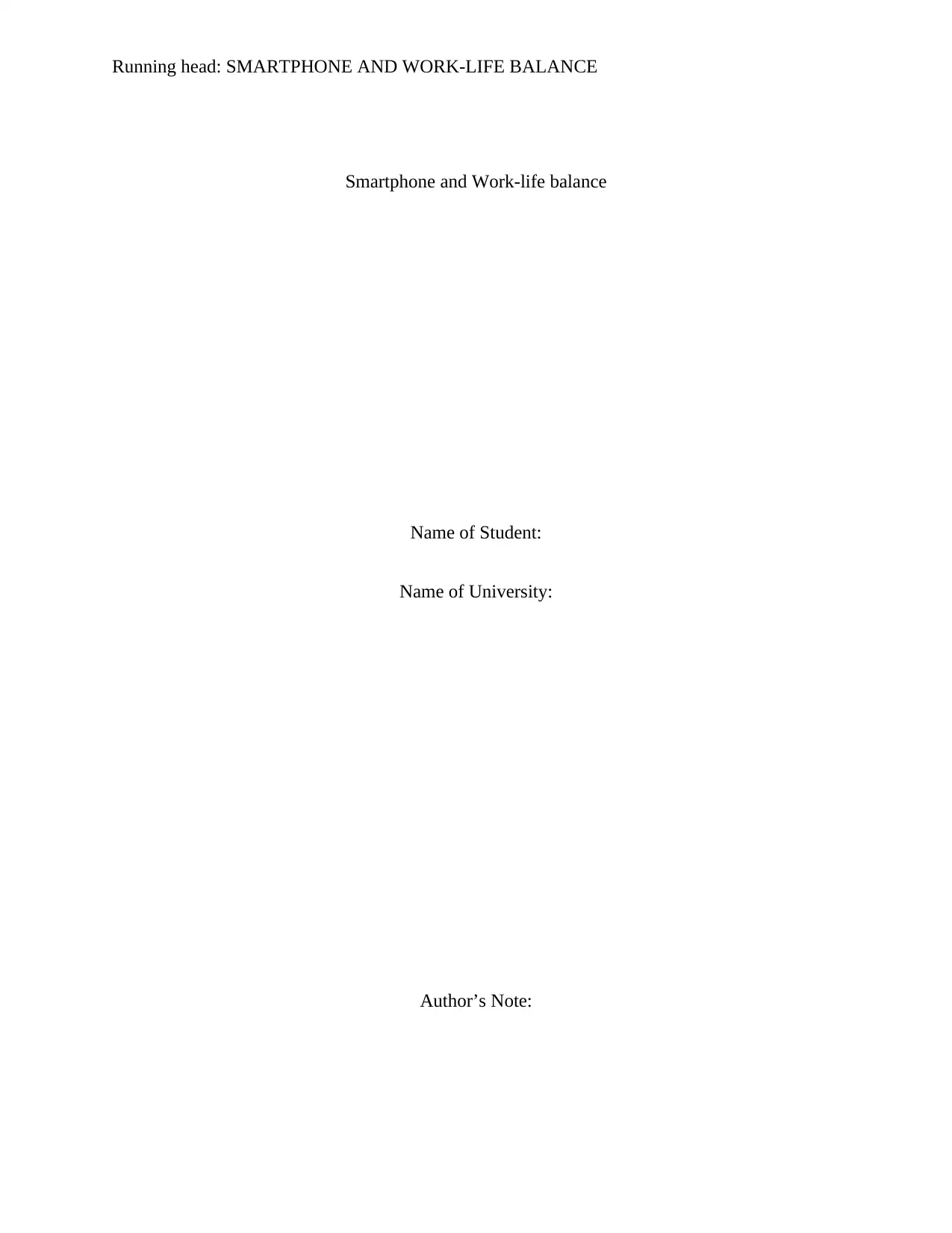
Running head: SMARTPHONE AND WORK-LIFE BALANCE
Smartphone and Work-life balance
Name of Student:
Name of University:
Author’s Note:
Smartphone and Work-life balance
Name of Student:
Name of University:
Author’s Note:
Paraphrase This Document
Need a fresh take? Get an instant paraphrase of this document with our AI Paraphraser
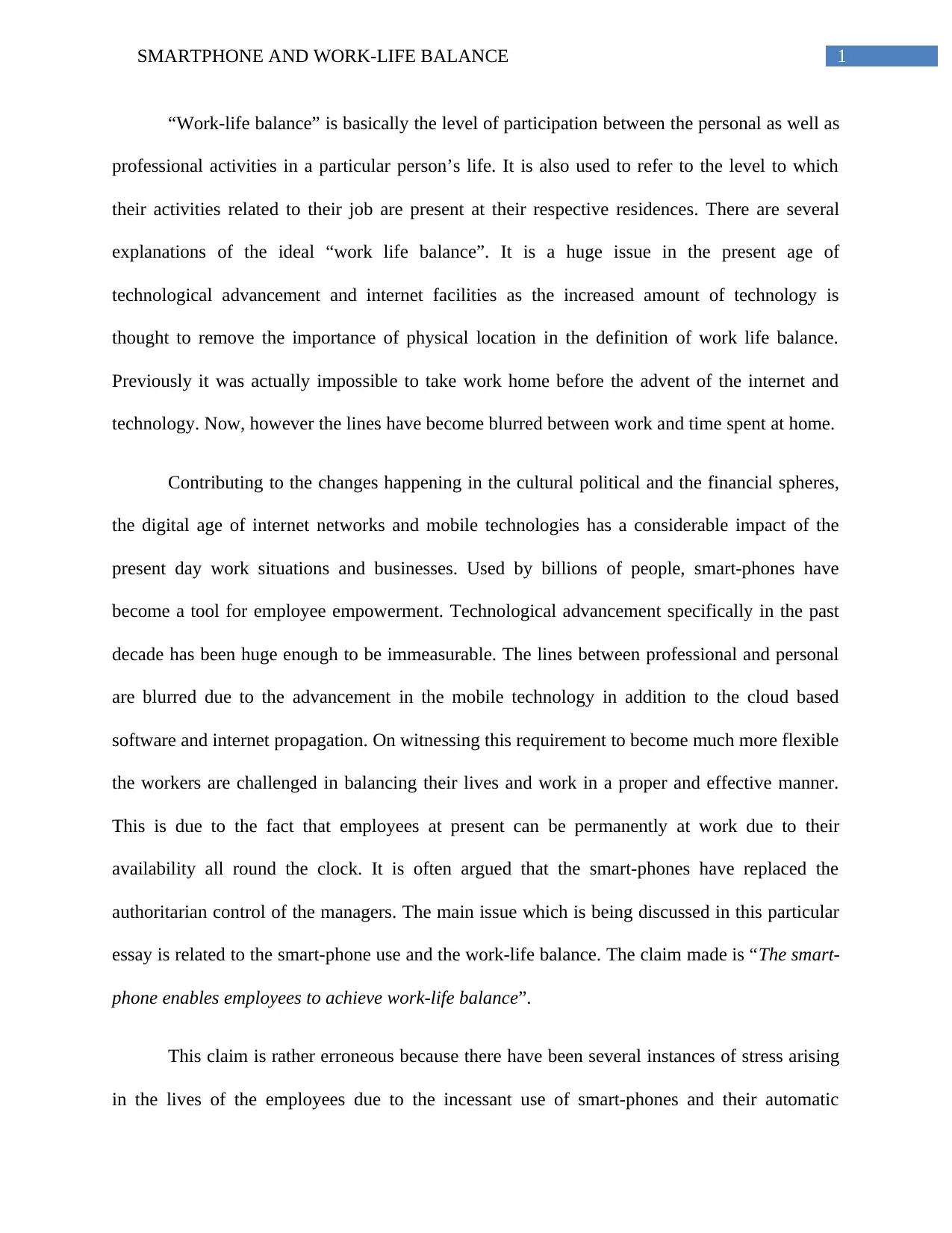
1SMARTPHONE AND WORK-LIFE BALANCE
“Work-life balance” is basically the level of participation between the personal as well as
professional activities in a particular person’s life. It is also used to refer to the level to which
their activities related to their job are present at their respective residences. There are several
explanations of the ideal “work life balance”. It is a huge issue in the present age of
technological advancement and internet facilities as the increased amount of technology is
thought to remove the importance of physical location in the definition of work life balance.
Previously it was actually impossible to take work home before the advent of the internet and
technology. Now, however the lines have become blurred between work and time spent at home.
Contributing to the changes happening in the cultural political and the financial spheres,
the digital age of internet networks and mobile technologies has a considerable impact of the
present day work situations and businesses. Used by billions of people, smart-phones have
become a tool for employee empowerment. Technological advancement specifically in the past
decade has been huge enough to be immeasurable. The lines between professional and personal
are blurred due to the advancement in the mobile technology in addition to the cloud based
software and internet propagation. On witnessing this requirement to become much more flexible
the workers are challenged in balancing their lives and work in a proper and effective manner.
This is due to the fact that employees at present can be permanently at work due to their
availability all round the clock. It is often argued that the smart-phones have replaced the
authoritarian control of the managers. The main issue which is being discussed in this particular
essay is related to the smart-phone use and the work-life balance. The claim made is “The smart-
phone enables employees to achieve work-life balance”.
This claim is rather erroneous because there have been several instances of stress arising
in the lives of the employees due to the incessant use of smart-phones and their automatic
“Work-life balance” is basically the level of participation between the personal as well as
professional activities in a particular person’s life. It is also used to refer to the level to which
their activities related to their job are present at their respective residences. There are several
explanations of the ideal “work life balance”. It is a huge issue in the present age of
technological advancement and internet facilities as the increased amount of technology is
thought to remove the importance of physical location in the definition of work life balance.
Previously it was actually impossible to take work home before the advent of the internet and
technology. Now, however the lines have become blurred between work and time spent at home.
Contributing to the changes happening in the cultural political and the financial spheres,
the digital age of internet networks and mobile technologies has a considerable impact of the
present day work situations and businesses. Used by billions of people, smart-phones have
become a tool for employee empowerment. Technological advancement specifically in the past
decade has been huge enough to be immeasurable. The lines between professional and personal
are blurred due to the advancement in the mobile technology in addition to the cloud based
software and internet propagation. On witnessing this requirement to become much more flexible
the workers are challenged in balancing their lives and work in a proper and effective manner.
This is due to the fact that employees at present can be permanently at work due to their
availability all round the clock. It is often argued that the smart-phones have replaced the
authoritarian control of the managers. The main issue which is being discussed in this particular
essay is related to the smart-phone use and the work-life balance. The claim made is “The smart-
phone enables employees to achieve work-life balance”.
This claim is rather erroneous because there have been several instances of stress arising
in the lives of the employees due to the incessant use of smart-phones and their automatic
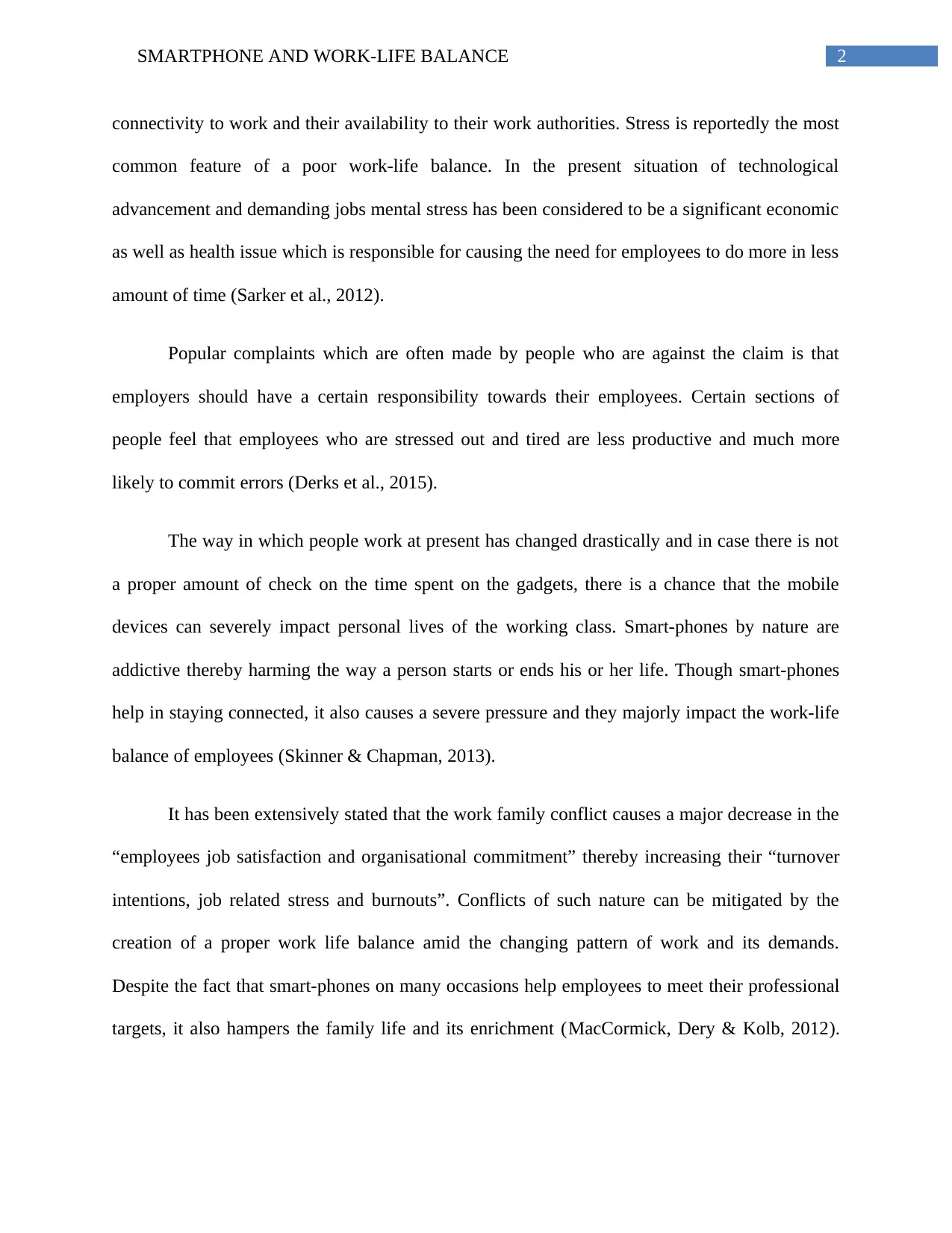
2SMARTPHONE AND WORK-LIFE BALANCE
connectivity to work and their availability to their work authorities. Stress is reportedly the most
common feature of a poor work-life balance. In the present situation of technological
advancement and demanding jobs mental stress has been considered to be a significant economic
as well as health issue which is responsible for causing the need for employees to do more in less
amount of time (Sarker et al., 2012).
Popular complaints which are often made by people who are against the claim is that
employers should have a certain responsibility towards their employees. Certain sections of
people feel that employees who are stressed out and tired are less productive and much more
likely to commit errors (Derks et al., 2015).
The way in which people work at present has changed drastically and in case there is not
a proper amount of check on the time spent on the gadgets, there is a chance that the mobile
devices can severely impact personal lives of the working class. Smart-phones by nature are
addictive thereby harming the way a person starts or ends his or her life. Though smart-phones
help in staying connected, it also causes a severe pressure and they majorly impact the work-life
balance of employees (Skinner & Chapman, 2013).
It has been extensively stated that the work family conflict causes a major decrease in the
“employees job satisfaction and organisational commitment” thereby increasing their “turnover
intentions, job related stress and burnouts”. Conflicts of such nature can be mitigated by the
creation of a proper work life balance amid the changing pattern of work and its demands.
Despite the fact that smart-phones on many occasions help employees to meet their professional
targets, it also hampers the family life and its enrichment (MacCormick, Dery & Kolb, 2012).
connectivity to work and their availability to their work authorities. Stress is reportedly the most
common feature of a poor work-life balance. In the present situation of technological
advancement and demanding jobs mental stress has been considered to be a significant economic
as well as health issue which is responsible for causing the need for employees to do more in less
amount of time (Sarker et al., 2012).
Popular complaints which are often made by people who are against the claim is that
employers should have a certain responsibility towards their employees. Certain sections of
people feel that employees who are stressed out and tired are less productive and much more
likely to commit errors (Derks et al., 2015).
The way in which people work at present has changed drastically and in case there is not
a proper amount of check on the time spent on the gadgets, there is a chance that the mobile
devices can severely impact personal lives of the working class. Smart-phones by nature are
addictive thereby harming the way a person starts or ends his or her life. Though smart-phones
help in staying connected, it also causes a severe pressure and they majorly impact the work-life
balance of employees (Skinner & Chapman, 2013).
It has been extensively stated that the work family conflict causes a major decrease in the
“employees job satisfaction and organisational commitment” thereby increasing their “turnover
intentions, job related stress and burnouts”. Conflicts of such nature can be mitigated by the
creation of a proper work life balance amid the changing pattern of work and its demands.
Despite the fact that smart-phones on many occasions help employees to meet their professional
targets, it also hampers the family life and its enrichment (MacCormick, Dery & Kolb, 2012).
⊘ This is a preview!⊘
Do you want full access?
Subscribe today to unlock all pages.

Trusted by 1+ million students worldwide
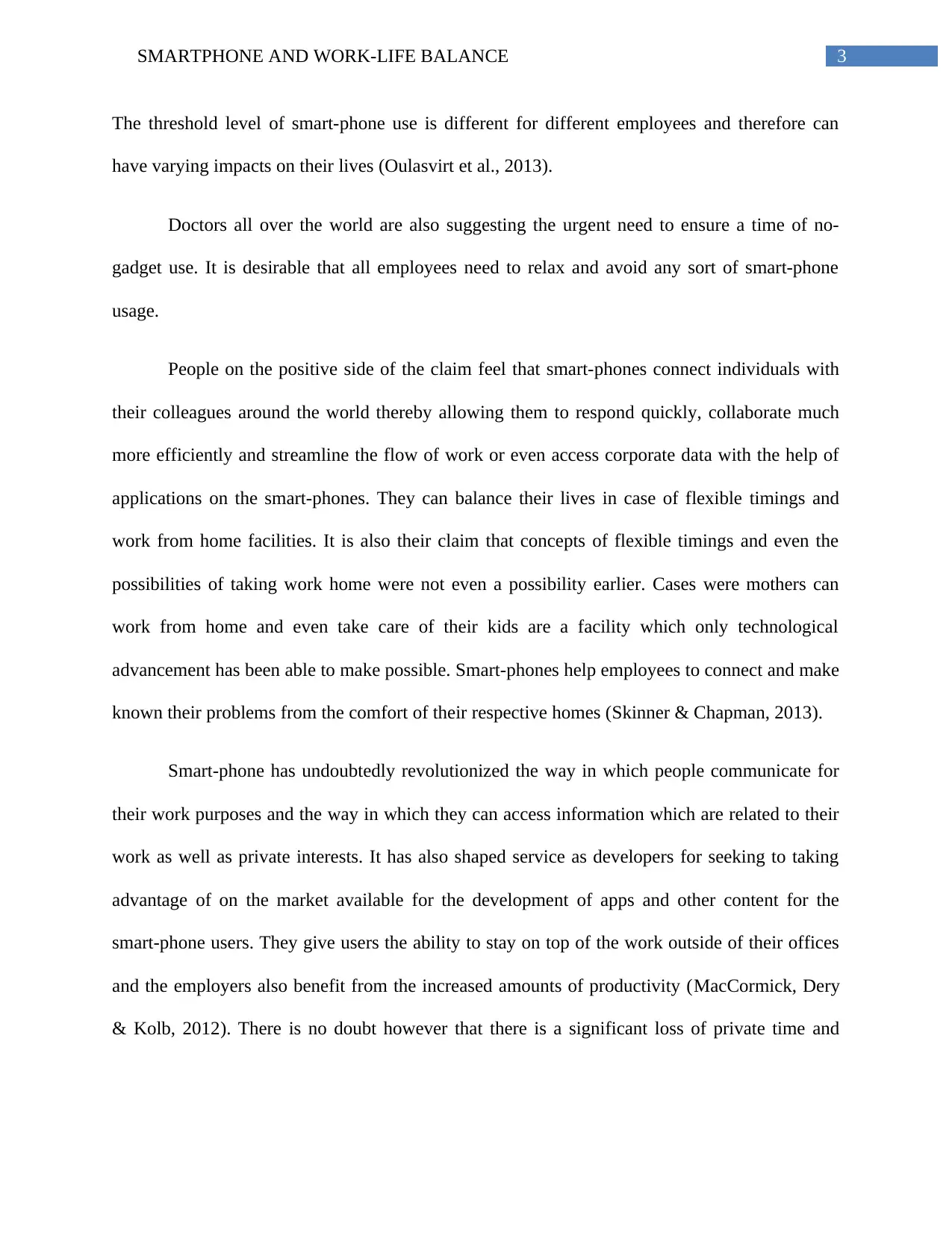
3SMARTPHONE AND WORK-LIFE BALANCE
The threshold level of smart-phone use is different for different employees and therefore can
have varying impacts on their lives (Oulasvirt et al., 2013).
Doctors all over the world are also suggesting the urgent need to ensure a time of no-
gadget use. It is desirable that all employees need to relax and avoid any sort of smart-phone
usage.
People on the positive side of the claim feel that smart-phones connect individuals with
their colleagues around the world thereby allowing them to respond quickly, collaborate much
more efficiently and streamline the flow of work or even access corporate data with the help of
applications on the smart-phones. They can balance their lives in case of flexible timings and
work from home facilities. It is also their claim that concepts of flexible timings and even the
possibilities of taking work home were not even a possibility earlier. Cases were mothers can
work from home and even take care of their kids are a facility which only technological
advancement has been able to make possible. Smart-phones help employees to connect and make
known their problems from the comfort of their respective homes (Skinner & Chapman, 2013).
Smart-phone has undoubtedly revolutionized the way in which people communicate for
their work purposes and the way in which they can access information which are related to their
work as well as private interests. It has also shaped service as developers for seeking to taking
advantage of on the market available for the development of apps and other content for the
smart-phone users. They give users the ability to stay on top of the work outside of their offices
and the employers also benefit from the increased amounts of productivity (MacCormick, Dery
& Kolb, 2012). There is no doubt however that there is a significant loss of private time and
The threshold level of smart-phone use is different for different employees and therefore can
have varying impacts on their lives (Oulasvirt et al., 2013).
Doctors all over the world are also suggesting the urgent need to ensure a time of no-
gadget use. It is desirable that all employees need to relax and avoid any sort of smart-phone
usage.
People on the positive side of the claim feel that smart-phones connect individuals with
their colleagues around the world thereby allowing them to respond quickly, collaborate much
more efficiently and streamline the flow of work or even access corporate data with the help of
applications on the smart-phones. They can balance their lives in case of flexible timings and
work from home facilities. It is also their claim that concepts of flexible timings and even the
possibilities of taking work home were not even a possibility earlier. Cases were mothers can
work from home and even take care of their kids are a facility which only technological
advancement has been able to make possible. Smart-phones help employees to connect and make
known their problems from the comfort of their respective homes (Skinner & Chapman, 2013).
Smart-phone has undoubtedly revolutionized the way in which people communicate for
their work purposes and the way in which they can access information which are related to their
work as well as private interests. It has also shaped service as developers for seeking to taking
advantage of on the market available for the development of apps and other content for the
smart-phone users. They give users the ability to stay on top of the work outside of their offices
and the employers also benefit from the increased amounts of productivity (MacCormick, Dery
& Kolb, 2012). There is no doubt however that there is a significant loss of private time and
Paraphrase This Document
Need a fresh take? Get an instant paraphrase of this document with our AI Paraphraser
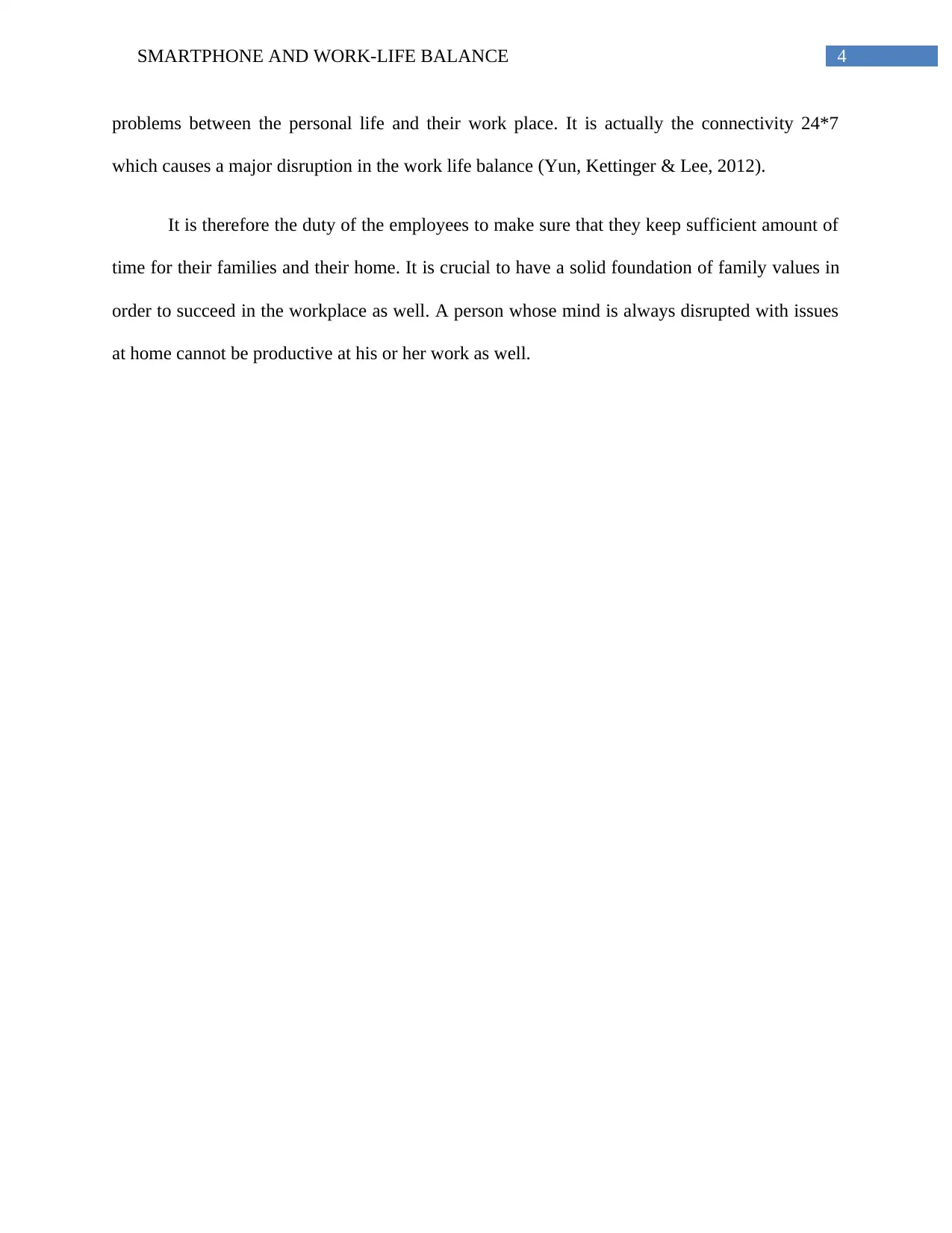
4SMARTPHONE AND WORK-LIFE BALANCE
problems between the personal life and their work place. It is actually the connectivity 24*7
which causes a major disruption in the work life balance (Yun, Kettinger & Lee, 2012).
It is therefore the duty of the employees to make sure that they keep sufficient amount of
time for their families and their home. It is crucial to have a solid foundation of family values in
order to succeed in the workplace as well. A person whose mind is always disrupted with issues
at home cannot be productive at his or her work as well.
problems between the personal life and their work place. It is actually the connectivity 24*7
which causes a major disruption in the work life balance (Yun, Kettinger & Lee, 2012).
It is therefore the duty of the employees to make sure that they keep sufficient amount of
time for their families and their home. It is crucial to have a solid foundation of family values in
order to succeed in the workplace as well. A person whose mind is always disrupted with issues
at home cannot be productive at his or her work as well.
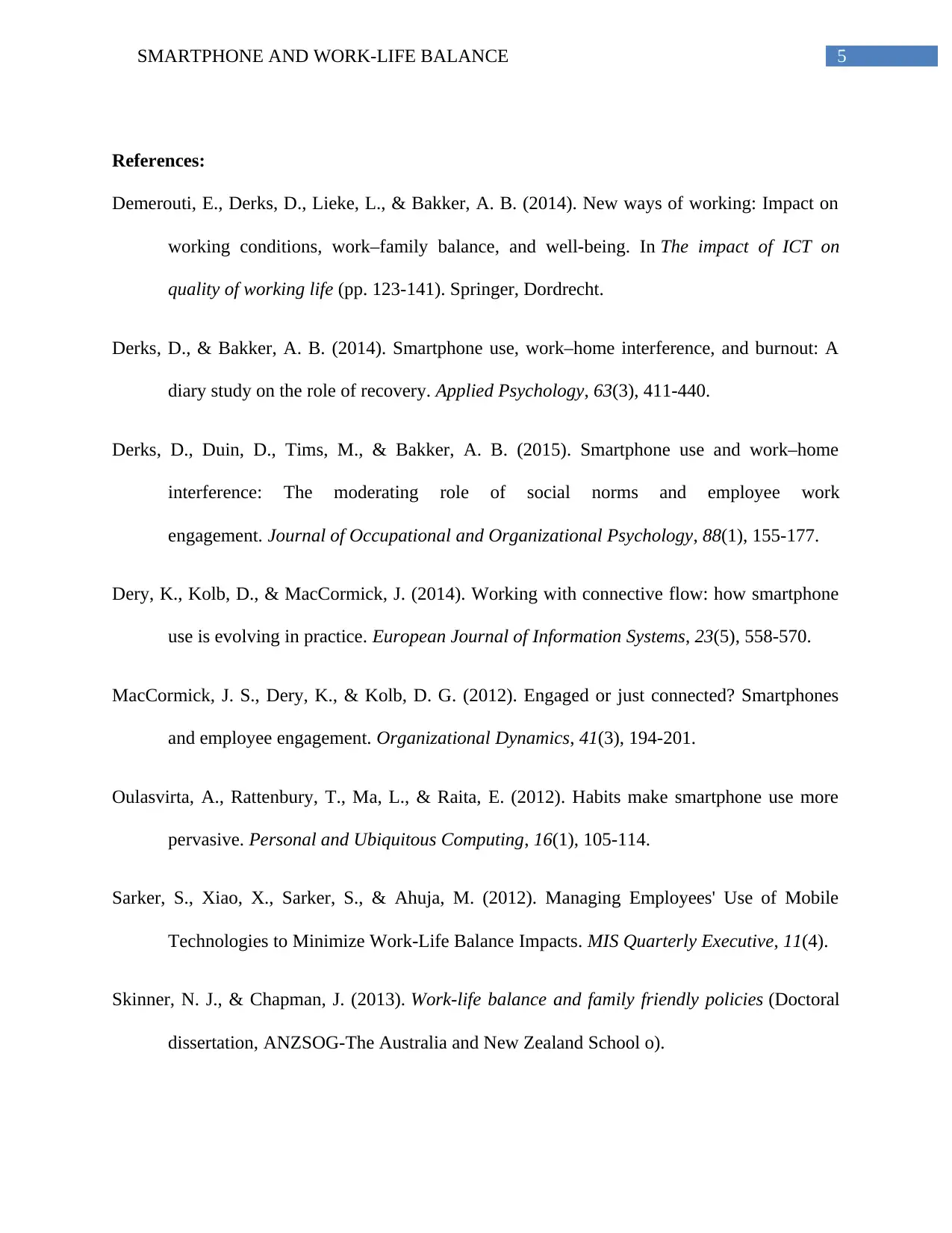
5SMARTPHONE AND WORK-LIFE BALANCE
References:
Demerouti, E., Derks, D., Lieke, L., & Bakker, A. B. (2014). New ways of working: Impact on
working conditions, work–family balance, and well-being. In The impact of ICT on
quality of working life (pp. 123-141). Springer, Dordrecht.
Derks, D., & Bakker, A. B. (2014). Smartphone use, work–home interference, and burnout: A
diary study on the role of recovery. Applied Psychology, 63(3), 411-440.
Derks, D., Duin, D., Tims, M., & Bakker, A. B. (2015). Smartphone use and work–home
interference: The moderating role of social norms and employee work
engagement. Journal of Occupational and Organizational Psychology, 88(1), 155-177.
Dery, K., Kolb, D., & MacCormick, J. (2014). Working with connective flow: how smartphone
use is evolving in practice. European Journal of Information Systems, 23(5), 558-570.
MacCormick, J. S., Dery, K., & Kolb, D. G. (2012). Engaged or just connected? Smartphones
and employee engagement. Organizational Dynamics, 41(3), 194-201.
Oulasvirta, A., Rattenbury, T., Ma, L., & Raita, E. (2012). Habits make smartphone use more
pervasive. Personal and Ubiquitous Computing, 16(1), 105-114.
Sarker, S., Xiao, X., Sarker, S., & Ahuja, M. (2012). Managing Employees' Use of Mobile
Technologies to Minimize Work-Life Balance Impacts. MIS Quarterly Executive, 11(4).
Skinner, N. J., & Chapman, J. (2013). Work-life balance and family friendly policies (Doctoral
dissertation, ANZSOG-The Australia and New Zealand School o).
References:
Demerouti, E., Derks, D., Lieke, L., & Bakker, A. B. (2014). New ways of working: Impact on
working conditions, work–family balance, and well-being. In The impact of ICT on
quality of working life (pp. 123-141). Springer, Dordrecht.
Derks, D., & Bakker, A. B. (2014). Smartphone use, work–home interference, and burnout: A
diary study on the role of recovery. Applied Psychology, 63(3), 411-440.
Derks, D., Duin, D., Tims, M., & Bakker, A. B. (2015). Smartphone use and work–home
interference: The moderating role of social norms and employee work
engagement. Journal of Occupational and Organizational Psychology, 88(1), 155-177.
Dery, K., Kolb, D., & MacCormick, J. (2014). Working with connective flow: how smartphone
use is evolving in practice. European Journal of Information Systems, 23(5), 558-570.
MacCormick, J. S., Dery, K., & Kolb, D. G. (2012). Engaged or just connected? Smartphones
and employee engagement. Organizational Dynamics, 41(3), 194-201.
Oulasvirta, A., Rattenbury, T., Ma, L., & Raita, E. (2012). Habits make smartphone use more
pervasive. Personal and Ubiquitous Computing, 16(1), 105-114.
Sarker, S., Xiao, X., Sarker, S., & Ahuja, M. (2012). Managing Employees' Use of Mobile
Technologies to Minimize Work-Life Balance Impacts. MIS Quarterly Executive, 11(4).
Skinner, N. J., & Chapman, J. (2013). Work-life balance and family friendly policies (Doctoral
dissertation, ANZSOG-The Australia and New Zealand School o).
⊘ This is a preview!⊘
Do you want full access?
Subscribe today to unlock all pages.

Trusted by 1+ million students worldwide
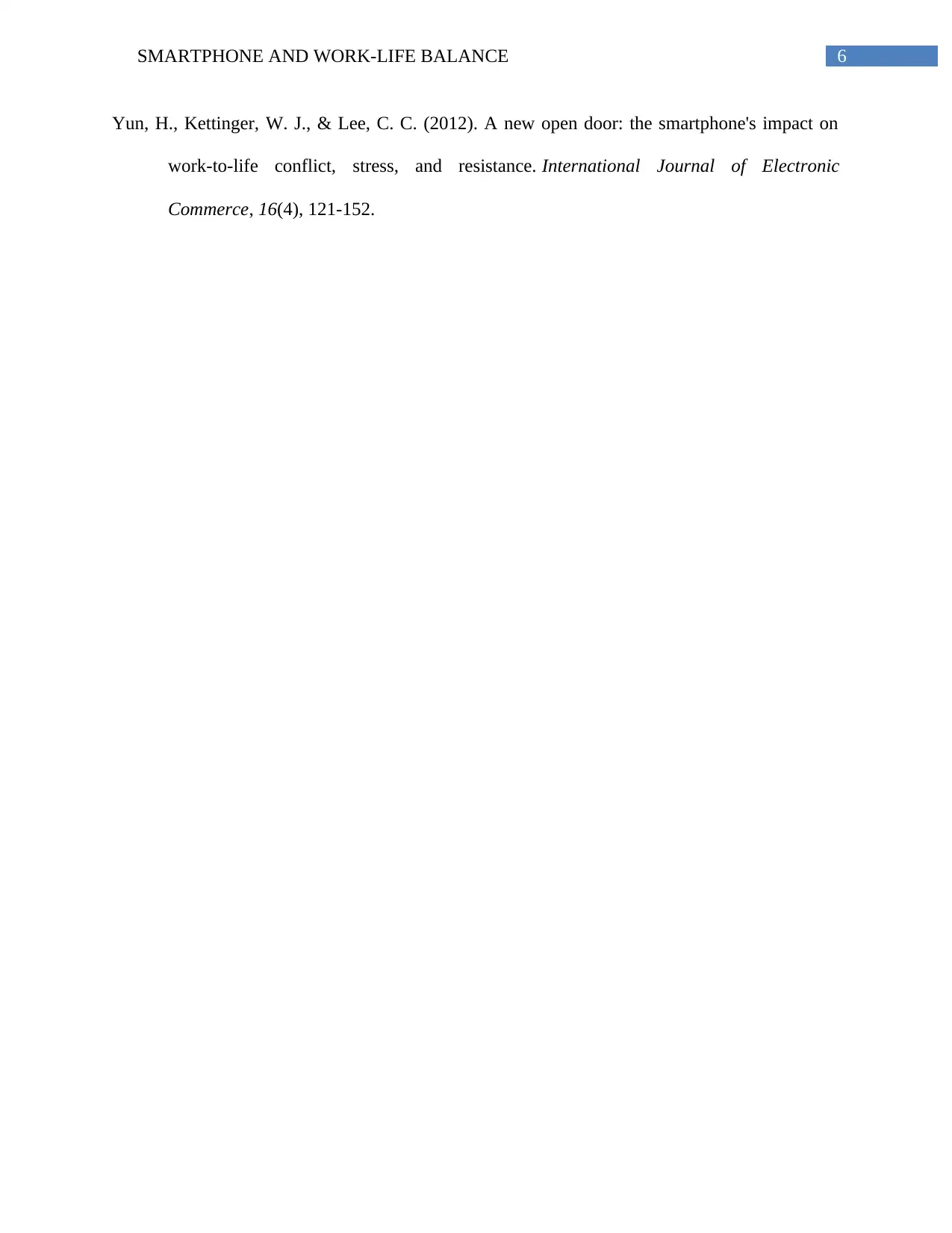
6SMARTPHONE AND WORK-LIFE BALANCE
Yun, H., Kettinger, W. J., & Lee, C. C. (2012). A new open door: the smartphone's impact on
work-to-life conflict, stress, and resistance. International Journal of Electronic
Commerce, 16(4), 121-152.
Yun, H., Kettinger, W. J., & Lee, C. C. (2012). A new open door: the smartphone's impact on
work-to-life conflict, stress, and resistance. International Journal of Electronic
Commerce, 16(4), 121-152.
1 out of 7
Related Documents
Your All-in-One AI-Powered Toolkit for Academic Success.
+13062052269
info@desklib.com
Available 24*7 on WhatsApp / Email
![[object Object]](/_next/static/media/star-bottom.7253800d.svg)
Unlock your academic potential
Copyright © 2020–2025 A2Z Services. All Rights Reserved. Developed and managed by ZUCOL.




